How to pick a flea and tick medication for your dog or cat | Dr. Justine Lee
As an emergency critical care specialist, I don’t “do” flea and tick medications. In other words, since I work at a specialty clinic, we don’t sell these products (you can buy these directly at your veterinarian, at your local pet store, or online). In a future blog, I’ll discuss the pros and cons of buying from 3 different sources (and why I would personally only buy it from your veterinarian and not online). In today’s blog, I’ll discuss the pros and cons of using different products out there. To prevent any bias, these are presented alphabetically by brand name below. Also, to best protect your dog and cat from problems with flea and tick medication, please read this great information from the CDC here.
Also, note that when it comes to certain types of routes of delivery (e.g., if the product is topical versus oral versus collar), there are general pros and cons of each. When in doubt, it depends on the exposure to other species (e.g., cats, children, rabbits) via secondary contact, comfort level, ease of administration (e.g., some cat owners can’t pill their cat, so prefer a topical), etc. My general take is below:
- Topicals: can result in secondary exposure to other species; can cause a topical reaction in sensitive animals; rarely can cause hair loss (temporary) at the site of application; ease of administration for pet owners who can’t pill their pet.
- Orals: often delivered in a tasty medication; can occasionally cause stomach upset in sensitive animals; rarely can cause vomiting
- Collars: can cause irritation at the site of the collar; can accidentally be chewed on and ingested (resulting in a potential poisoning or foreign body); can be poisonous if accidentally ingested (e.g., amitraz); can rarely fall off or get caught.

Activyl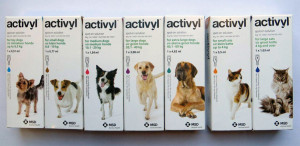
- What does it kill? Kills fleas for dogs and cats
- Route: Topical
- How long does it last for? 1 month
- Active ingredient: Inoxacarb
- How does it work? Inoxacarb is an oxadiazine insecticide that blocks insect sodium channels and results in neurologic signs in the insect; this ingredient was originally developed to control pests on food crops
- How effective is it? Kills fleas within 8 hours; lasts for 30 days
- How do you apply it? Topically onto the skin, waterproof
- Pros: Kills fleas quickly; good for pet owners who can’t pill their cat; can be used in dogs and cats > 8 weeks of age; can be used for dogs > 4 pounds and cats > 2 pounds)
- Cons: Doesn’t provide any tick preventative
- When you shouldn’t use it (Called “Contraindications”): Any known previous reactions to it
- Availability: At your veterinarian
- Made by: Merck Animal Health
- More information can be found here: http://www.mypet.com/activyl.aspx
Activyl Tick Plus 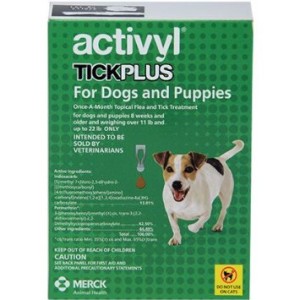
- What does it kill? Kills fleas and kills and repels ticks for dogs; NOT to be used in cats
- Route: Topical
- How long does it last for? 1 month
- Active ingredient: Inoxacarb and a high concentration permethrin
- How does it work? Inoxacarb is an oxadiazine insecticide that blocks insect sodium channels and results in neurologic signs in the insect; permethrin is a chemical that affects the sodium channels in the neurologic system of the insect
- How effective is it? Kills fleas within 8 hours; kills and repels ticks for 30 days
- How do you apply it? Topically onto the skin, waterproof
- Pros: Kills fleas quickly; due to the high concentration permethrin, provides a repellant in addition to killing ticks
- Cons: Large topical volume to apply; toxic to cats; with dogs and cats living together, cats should be separated from dogs until the product is completely dried on the dog
- When you shouldn’t use it (Called “Contraindications”): Should never be applied to cats!
- Availability: At your veterinarian
- Made by: Merck Animal Health
- More information can be found here: http://www.mypet.com/activyl.aspx
Advantage II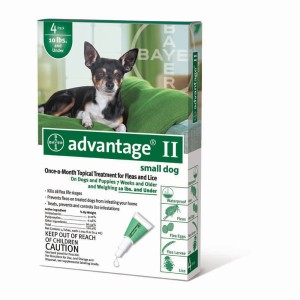
- What does it kill? Kills fleas for cats and dogs
- Route: Topical spot-on
- How long does it last for? 1 month
- Active ingredient: An insect growth regulator (IGR) called imidacloprid (9.1%) and pyriproxyfen (0.46%), a potent insect juvenile hormone that affects normal development of flea development
- How does it work? Imidacloprid acts like nicotine and disrupts the nervous system of the insect. Pyriproxyfen (0.44%) is a potent insect juvenile hormone that affects normal development of flea development.
- How effective is it? Kills 98% fleas within 12 hours; in cats, by day 28, only 73% of re-infested fleas were killed within 48 hours (in one study)
- How do you apply it? Topically onto the skin, waterproof
- Pros: Kills fleas quickly; for dogs > 7 weeks of age; for cats > 8 weeks of age; kills lice too (rare in dogs)
- Cons: Topical only; doesn’t kill ticks at all! Imidacloprid is a neonicotinoid, and has been associated with killing bees in the environment (when used for crop dusting, etc.), so I prefer not to use it for environmental reasons, personally (but I’m crunchy and eco-friendly that way). You can read more about it from the EPA here and by Mother Jones here.
- When you shouldn’t use it (Called “Contraindications”): Any known sensitivity to the ingredients
- Availability: Over the counter at PetCo or PetSmart or at your veterinarian
- Made by: Bayer Animal Health
- More information can be found here: http://www.petparents.com/products.aspx/about/advantage-ii-for-dogs or http://www.petparents.com/products.aspx/about/advantage-ii-for-cats
Advantage Multi
- What does it kill? Heartworm preventative; kills adult fleas, roundworms, hookworms, whipworms, and sarcoptic mange
- Route: Topical
- How long does it last for? 1 month
- Active ingredient: An insect growth regulator (IGR) called imidacloprid (9.1%) and moxidectin
- How does it work? Imidacloprid acts like nicotine and disrupts the nervous system of the insect. Moxidectin, which is in the class of macrocyclic lactone drugs, affects chloride ion channel activity in the nervous system of insects.
- How effective is it? Kills fleas and prevents heartworm
- How do you apply it? Topically onto the skin
- Pros: If your dog doesn’t like a monthly tasty chew for heartworm, you can give it topically instead; can be used off label to treat demodectic mange in dogs
- Cons: Does not provide any tick protection; must have a heartworm test prior to starting this medication; oily substance applied to the back; children should not be exposed to the dog for 2 hours until the product is completely dried.
- When you shouldn’t use it (Called “Contraindications”): If your dog is heartworm positive, consult with your veterinarian before using it!
- Availability: At your veterinarian
- Made by: Bayer Animal Health
- More information can be found here: http://www.bayerdvm.com/show.aspx/productdetail/advantage-multi-for-dogs/fleas-sarcoptic-mange-detail
K9 Advantix
- What does it kill? Kills and repels fleas, ticks (Deer ticks, American dog tick, Brown dog, Lone Star ticks), flea eggs and larvae, mosquitos, and lice; also repels (but does not kill) biting flies
- Route: Topical
- How long does it last for? 1 month
- Active ingredient: High concentration permethrin (44%), an insect growth regulator (IGR) called imidacloprid (8.8%), and pyriproxyfen (0.44%), a potent insect juvenile hormone that affects normal development of flea development
- How does it work? Permethrin, which is a chemical that affects the sodium channels in the neurologic system of the insect; imidacloprid acts like nicotine and disrupts the nervous system of the insect
- How effective is it? Kills fleas within 12 hours; kills ticks as early as 10 minutes and up to 3 days on previously untreated dogs
- How do you apply it? Topically onto the skin, waterproof
- Pros: Kills fleas and ticks quickly; provides a repellant in addition to killing ticks
- Cons: If accidentally applied to a cat, can result in life-threatening seizures, tremors and death; can result in an adverse reaction called parasthesia (e.g., intense tingling/stinging sensation) and secondary trauma to the site of application in dogs; with dogs and cats living together, cats should be separated from dogs until the product is completely dried on the dog. Also, imidacloprid is a neonicotinoid, and has been associated with killing bees in the environment (when used for crop dusting, etc.), so I prefer not to use it for environmental reasons, personally (but I’m crunchy and eco-friendly that way). You can read more about it from the EPA here and by Mother Jones here.
- When you shouldn’t use it (Called “Contraindications”): If the product contains a high concentration pyrethrin, it should NEVER be used in cats
- Availability: Over the counter at PetCo or PetSmart or at your veterinarian
- Made by: Bayer Animal Health
- More information can be found here: http://www.petparents.com/products.aspx/index/k9-advantix-ii
Bravecto 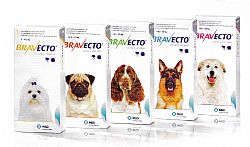
- What does it kill? Kills adult fleas and ticks (black-legged tick, American dog tick, brown dog tick, and lone star ticks) on dogs; recently found to treat demodex (mange) within just 1-2 doses.
- Route: Oral and topical
- How long does it last for? It works for 12 weeks (3 months) for fleas and most ticks (it works 8 weeks for lone star ticks or Amblyomma ticks)
- Active ingredient: Fluralaner
- How does it work? Class of isoxazoline products that inhibits the bug’s nervous system
- How effective is it? Kills 98%-100 of fleas and ticks in 12 hours for 12 weeks
- How do you apply it? Orally (with food)
- Pros: Kills fleas and ticks quickly; palatable chew that can be used even in dogs with food allergies; lasts a long time (typically 12 weeks); one of the few flea/tick medications that can be given to pregnant, lactating or breeding animals (which is a very hard label claim to get due to rigorous study design and testing); no oily medication applied to the skin; high efficacy and fast kill, which helps prevent Lyme disease; for sure in dogs > 6 months of age (because of the rapid growth in puppies) and > 4 pounds; shown to work to control demodectic mange (off-label) which is great if you don’t want to dose with daily ivermectin for 3 months at a time!
- Cons: Can occasionally cause vomiting; no repellency (e.g., can’t prevent or repel insects); can only be used in dogs > 6 months (due to the growing age and the change in weight over 12 weeks during the puppy stage); now available for cats
- When you shouldn’t use it (Called “Contraindications”): Previous reaction or any known sensitivity to the ingredients; drugs from the isoxazoline group may cause abnormal neurologic signs such as tremors, unsteadiness, and/or seizures.
- Availability: Only by your veterinarian
- Made by: Merck Animal Health
- More information can be found here: http://us.bravovets.com/
Bravecto Plus (for cats)
- What does it kill? Kills adult fleas and ticks [(Ixodes scapularis; black-legged tick) and Dermacentor variabilis; (American dog tick)], heartworm, intestinal roundworm and hookworm
- Route: Topical (I mean, who can pill a cat?)
- How long does it last for? It works for 8 weeks (2 months)
- Active ingredient: Fluralaner and moxidectin
- How does it work? Fluralaner is from the class of isoxazoline products that inhibits the bug’s nervous system. Moxidectin, which is in the class of macrocyclic lactone drugs, affects chloride ion channel activity in the nervous system of insects.
- How effective is it? Kills 100% of fleas and more than 99.7% of ticks in the first 12 hours after the product is applied. Prevents heartworm disease caused by Dirofilaria immitis. Treats intestinal roundworm (Toxocara cati; 4th stage larvae, immature adults and adults) and hookworm (Ancylostoma tubaeforme; 4th stage larvae, immature adults and adults).
- How do you apply it? Topically
- Pros: Kills fleas and ticks quickly; topical, as cats are harder to pill!
- Cons: Can’t use on really young kittens; only for kittens 6 months of age and older and weighing 2.6 lb. or greater.
- When you shouldn’t use it (Called “Contraindications”): Previous reaction or any known sensitivity to the ingredients; drugs from the isoxazoline group may cause abnormal neurologic signs such as tremors, unsteadiness, and/or seizures.
- Availability: Only by your veterinarian
- Made by: Merck Animal Health
- More information can be found here: http://us.bravovets.com/
Capstar 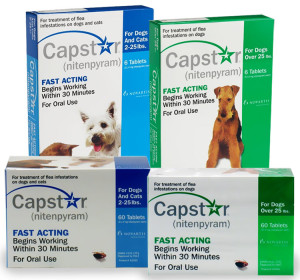
- What does it kill? Kills fleas in dogs and cats
- Route: Oral, a a single dose
- How long does it last for? Used as a single dose to kill fleas very quickly
- Active ingredient: Nitenpyram
- How does it work?
- How effective is it? Starts working within 30 minutes of administration; kills 96% of fleas within 2 hours in cats; by 8 hours, 98% of fleas are killed; similar results in dogs, with >98% of fleas killed within 4-6 hours of administration.
- How do you apply it? Orally
- Pros: Very fast onset of killing fleas; wide margin of safety in dogs and cats; kills very quickly; I like to use this for animals entering a shelter situation as it will kill fleas immediately so it prevents further spread to the shelter
- Cons: Flea-infested cats can show temporary increases in itching, scratching and grooming following treatment with Capstar (the fleas are intensely biting as they are dying off).
- When you shouldn’t use it (Called “Contraindications”): Previous reaction to the ingredients
- Availability: Over the counter
- Made by: Novartis
- More information can be found here: At the FDA here
Certifect 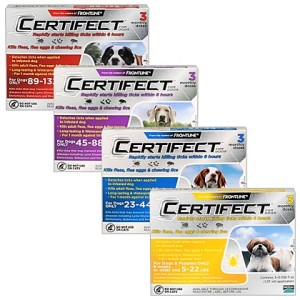
- What does it kill? Kills fleas and ticks for dogs only
- Route: Topical
- How long does it last for? 1 month
- Active ingredient: Fipronil; (S)-methoprene; amitraz
- How does it work? Fipronil, a chemical from the phenylpyrazole family, affects the neurologic system of the insect; (S)-methoprene, an insect growth regulator that acts as a hormone that prevents flea eggs and larvae from developing properly; Amitraz, a monoamine oxidase inhibitor that may have effects on the neurologic system of the insect.
- How effective is it? Kills fleas within 4 hours and up to 100% within 12 hours of contact; kills ticks on treated dogs in 6 hours and up to 100% within 18 hours of contact.
- How do you apply it? Topically onto the skin
- Pros: Wide margin of safety in dogs; ticks and fleas do not have to bite for it to work
- Cons: Oily medication applied to skin
- When you shouldn’t use it (Called “Contraindications”): Previous reaction to the ingredients; very poisonous to rabbits
- Availability: At your veterinarian
- Made by: Merial
- More information can be found here: http://www.certifect.com/Pages/default.aspx
Cheristin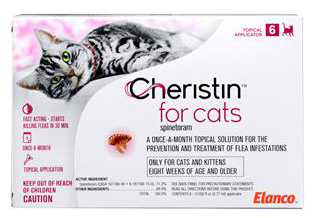
- What does it kill? Kills fleas on cats
- Route: Topical spot-on
- How long does it last for? It works for 4 weeks (1 month) for fleas
- Active ingredient: Spinetoram 11.2%
- How does it work? Activates nicotinic acetylcholine receptors, affecting the neurologic system of the insect
- How effective is it? Kills 100% of fleas in 12 hours; starts killing fleas within 30 minutes
- How do you apply it? Topically; apply to the skin at the base of the head
- Pros: Kills fleas quickly; labeled as monthly but actually works for 37 days (based on studies); for cats only; high efficacy and fast kill for fleas; kills fleas before they can lay eggs; low volume dose (< 1 ml per dose); works well for cat owners who can’t pill their cat.
- Cons: Doesn’t kill ticks; can occasionally cause application site reactions (e.g., hair loss, hair change, redness, etc); for cats > 8 weeks of age and > 2 pounds
- When you shouldn’t use it (Called “Contraindications”): If previous known reaction
- Availability: Only by your veterinarian
- Made by: Elanco Animal Health
- More information can be found here: https://www.cheristin4cats.com/
Comfortis
- What does it kill? Kills fleas on dogs and cats
- Route: Oral
- How long does it last for? It works for 30 days
- Active ingredient: Spinosad
- How does it work? Activates nicotinic acetylcholine receptors affecting the neurologic system of the insect
- How effective is it? Kills 98% of fleas in 4 hours for 1 month; killing of fleas starts within 30 minutes. According to some reports, kills approximately 60% of fleas within 1 hour of dosing in dogs (90% of fleas within 2 hours in cats)
- How do you apply it? Orally (with food)
- Pros: Kills fleas very quickly; lasts one month; can be used in both dogs and cats; high efficacy and fast kill for fleas; kills fleas before they can lay eggs; good for cats who are easily to pill and that groom excessively (so they don’t ingest a topical flea medication off); no oily medication applied to skin; approved for dogs and cats > 14 weeks of age (dogs must be > 3.3 pounds and cats > 2 pounds)
- Cons: Doesn’t kill ticks; can occasionally see vomiting with it; is not labelled for pregnant, lactating or breeding animals; pill doesn’t taste great; a significant portion of dogs can vomit after getting it; cannot be used when dogs are on high-dose ivermectin (e.g., for demodex mange); don’t use in dogs that have a history of seizures either (IMO)
- When you shouldn’t use it (Called “Contraindications”): Should not be used if your dog is on high-dose ivermectin (a medication for demodex/mange); in dogs with a history of seizures; in breeding females
- Availability: Only by your veterinarian
- Made by: Elanco Animal Health
- More information can be found here: https://www.comfortis.com/
Credelio
- What does it kill? Kills adult fleas and controls tick infestations [Amblyomma americanum (lone star tick), Dermacentor variabilis (American dog tick), Ixodes scapularis (black-legged tick) and Rhipicephalus sanguineus (brown dog tick)
- Route: Orally with food (or within 30 minutes of food)
- How long does it last for? It works for 30 days
- Active ingredient: Lotilaner
- How does it work? Lotilaner is a novel isoxazoline that has recently been approved for use in dogs for the rapid and sustained elimination of flea and tick infestations. Members of the isoxazoline class have been shown to kill insects and acari by interfering with neuromuscular and central nervous neurotransmission through binding to receptors that activate ligand-gated chloride channels (γ-aminobutyric acid- and glutamate-gated chloride channels)” (Reference HERE).
- How effective is it?Kills adult fleas and controls tick infestations for one month in dogs and puppies 8 weeks of age and older, and weighing 4.4 pounds or greater.
- How do you apply it? Orally
- Pros: Oral; lasts one month; high efficacy and fast kill for fleas; no oily medication applied to skin
- Cons: Not for use in cats; has not been evaluated for use in breeding, pregnant or lactating dogs; Use with caution in dogs with a history of seizures. The most frequently reported adverse reactions are weight loss, elevated blood urea nitrogen, excessive urination, and diarrhea.
- When you shouldn’t use it (Called “Contraindications”): seizure disorders; Previous reaction or any known sensitivity to the ingredients; drugs from the isoxazoline group may cause abnormal neurologic signs such as tremors, unsteadiness, and/or seizures.
- Availability: Only by your veterinarian
- Made by: Elanco Animal Health
- More information can be found here: Credelio.com
Frontline Plus, Frontline Tritak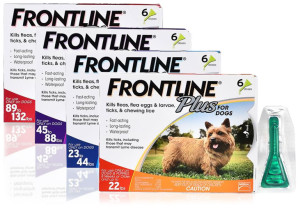
- What does it kill? Kills fleas and ticks
- Route: Topical spot-on
- How long does it last for? Lasts for 1 month
- Active ingredient: Fipronil, which is in the phenylpyrazole chemical family and (S)-methoprene; the Tritak for cats has etofenprox (a pyrethroid-ester) while the Tritak for dogs has cyphenothrin (a high concentration pyrethrin)
- How does it work? Fipronil: affects the neurologic system of the insect; (S)-methoprene: an insect growth regulator that acts as a hormone that prevents flea eggs and larvae from developing properly
- How effective is it? Kills fleas within 8-24 hours; kills ticks at 24-48 hours; Frontline Plus and Tritak kills 100% of fleas within 24 hours
- How do you apply it? Topically onto the skin
- Pros: Very wide margin of safety; has been used for decades; safe even for cats; good for pets that are difficult to pill; Frontline Plus approved for dogs and cats > 8 weeks; Tritak is for dogs and cats > 12 weeks
- Cons: Oily medication applied to skin; studies have shown decreased efficacy to this product against fleas and ticks; kills ticks slowly as compared to new medications where diseases can potentially be transmitted in the 24-48 hour window
- When you shouldn’t use it (Called “Contraindications”): Previous reaction to the ingredients; very poisonous to rabbits
- Availability: Over the counter or at your veterinarian
- Made by: Merial
- More information can be found here: http://www.frontline.com/Pages/default.aspx
- NOTE: There are several generic products over-the-counter that also contain fipronil, the same active ingredient found in this product.
Hartz and Sergeant’s Flea and Tick Squeeze-On
- What does it kill? Kills fleas, ticks, mosquitos, flea eggs and larvae in dogs (depending on what specific OTC brand you buy and what combined active ingredients are in it). Not going to spend too much time on this one, as these two companies make many products with various ingredients – when in doubt, you can call the company directly or check with your veterinarian.
- Route: Topical
- How long does it last for? 1 month
- Active ingredient: Several different ingredients offered by these two companies, including high concentration permethrins; some types may be fipronil (what is found in Frontline) and/or (S)-methoprene, while other types contain natural essential oils.
- How does it work? Depending on the ingredient (e.g., permethrin, which is a chemical that affects the sodium channels in the neurologic system of the insect; fipronil, which is in the phenylpyrazole chemical family, affects the neurologic system of the insect; (S)-methoprene, which is an insect growth regulator and acts as a hormone that prevents flea eggs and larvae from developing properly)
- How effective is it?
- How do you apply it? Topically onto the skin
- Pros: Inexpensive and can be readily found at discount warehouse stores like Walmart, etc.; effective against fleas and ticks
- Cons: If the product contains a high concentration pyrethrin-type chemical (any active ingredient that ends with a “thrin”) and is accidentally applied to a cat, can result in life-threatening seizures, tremors and death; can result in an adverse reaction called parasthesia (e.g., intense tingling/stinging sensation) and secondary trauma to the site of application in dogs; as an emergency veterinarian, I see a lot of complications from pet owners using this without appropriate application (e.g., using it on a cat, using the wrong dose, etc.) and secondary side effects as a result
- When you shouldn’t use it (Called “Contraindications”): If the product contains a high concentration pyrethrin, it should NEVER be used in cats; if the product contains fipronil, it should never be used on or near rabbits
- Availability: Over the counter
- Made by: Multiple companies including Hartz and Sergeant’s
- More information can be found here: At the company website
NexGard
- What does it kill? Kills adult fleas and ticks (black-legged tick, American dog tick, brown dog tick, and lone star ticks) on dogs; has been anecdotally reported to help treat demodex (mange)
- Route: Oral
- How long does it last for? It works for 4 weeks (1 month) for fleas and ticks
- Active ingredient: Afoxolaner
- How does it work? Class of isoxazoline products that inhibits the bug’s nervous system
- How effective is it? Kills 99% of fleas and ticks in 8 hours for 4 weeks
- How do you apply it? Orally (with or without food)
- Pros: Kills fleas and ticks quickly; chewable medication (but in my dog’s opinion, not very palatable); no oily medication applied to the skin; high efficacy
- Cons: Can occasionally cause vomiting; no repellency (e.g., can’t prevent or repel insects); is not labelled for pregnant, lactating or breeding animals; not very palatable, according to Milo (my dog)
- When you shouldn’t use it (Called “Contraindications”): Should not be used if your dog has a history of seizures; previous reaction or any known sensitivity to the ingredients; drugs from the isoxazoline group may cause abnormal neurologic signs such as tremors, unsteadiness, and/or seizures.
- Availability: Only by your veterinarian
- Made by: Merial
- More information can be found here: http://www.nexgardfordogs.com/Pages/index.aspx
NexGard Spectra
- What does it kill? Kills adult fleas and indicated for the treatment and prevention of flea and tick infestations, also prevents heartworm disease and treats and controls hookworm, roundworm, whipworm, and lungworm infestations in dogs and puppies
- Route: Oral
- How long does it last for? It works for 4 weeks (1 month) for fleas and ticks
- Active ingredient: Afoxolaner, milbemycin oxime
- How does it work? Class of isoxazoline products that inhibits the bug’s nervous system; activates nicotinic acetylcholine receptors and binds to glutamate-gated chloride ion channels
- How effective is it? Kills 99% of fleas and ticks in 8 hours for 4 weeks
- How do you apply it? Orally (with or without food)
- Pros: Kills fleas and ticks quickly; beef-flavoured chew medication; no oily medication applied to the skin; high efficacy
- Cons: Can occasionally cause vomiting; no repellency (e.g., can’t prevent or repel insects); is not labelled for pregnant, lactating or breeding animals; not very palatable, according to Milo (my dog)
- When you shouldn’t use it (Called “Contraindications”): Should not be used if your dog has a history of seizures
- Availability: Only by your veterinarian
- Made by: Boehringer Ingelheim
- More information can be found here: https://www.boehringer-ingelheim.com/animal-health/companion-animals-products/nexgard-spectra
Preventic tick collar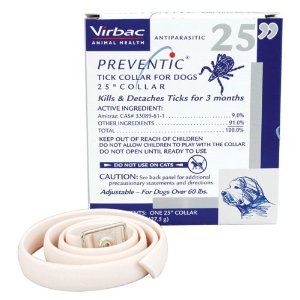
- What does it kill? Kills ticks in dogs only
- Route: Collar
- How long does it last for? For up to 90 days
- Active ingredient: Amitraz (9%)
- How does it work? Amitraz is a monoamine oxidase inhibitor, which may have effects on the neurologic system of the insect
- How effective is it? Kills ticks on treated dogs in 6 hours and up to 100% within 18 hours of contact.
- How do you apply it? Collar that you put around the neck of your dog
- Pros: Wide margin of safety in dogs; lasts 3 months; comes in 2 sizes (18″ and 25″ collars); inexpensive but effective; great add-on protection if you’re going to a tick-infested area to go hiking for the weekend!
- Cons: Doesn’t kill fleas; water-resistant (not proof), which means your dog can’t swim with it; can be poisonous if your dog swallows the whole collar!
- When you shouldn’t use it (Called “Contraindications”): Previous reaction to the ingredients
- Availability: At your veterinarian
- Made by: Virbac
- More information can be found here: http://www.virbacvet.com/products/detail/preventic-tick-collar-for-dogs
Revolution 
- What does it kill? Kills adult fleas, treats ear mites (Otodectes cynotis), prevents heartworm disease, prevents flea eggs from hatching, treats sarcoptic mange (Sarcoptes scabiei, different from demodex mange), controls American dog tick infestations, treats lice infestation in dogs and cats, and treats intestinal hookworm (Ancylostoma tubaeforme) and roundworms in dogs and cats
- Route: Topical spot-on
- How long does it last for? Lasts for 1 month
- Active ingredient: Selamectin 6%
- How does it work? Selamectin, which is in the class of macrocyclic lactone drugs, affects chloride ion channel activity in the nervous system of insects.
- How effective is it? Takes slightly longer to kill 100% of fleas as compared to other products (24-48 hours), but kills a whole lot of other bugs, lice, insects, worms, etc. too.
- How do you apply it? Topical
- Pros: Kills a lot of insects (e.g., heartworm, different manges, insects, mites, etc.); can be used in MDR dogs that are sensitive to ivermectin and other types of
- Cons: Only kills American dog tick, not the dangerous Lyme tick (Ixodes)
- When you shouldn’t use it (Called “Contraindications”): Any known sensitivity to the ingredients
- Availability: Only by your veterinarian
- Made by: Zoetis
- More information can be found here: https://www.revolution4dogs.com/
Revolution Plus
- What does it kill? Kills adult fleas (Ctenocephalides felis) and is indicated for the treatment and prevention of flea infestations, the treatment and control of tick infestations with Ixodes scapularis (black-legged tick), Amblyomma maculatum (Gulf Coast tick) and Dermacentor variabilis (American dog tick), the treatment and control of ear mite (Otodectes cynotis) infestations, and the treatment and control of roundworm (Toxocara cati) and intestinal hookworm (Ancylostoma tubaeforme) infections. Also used for the prevention of heartworm disease caused by Dirofilaria immitis.
- Route: Topical spot-on
- How long does it last for? Lasts for 1 month
- Active ingredient: Selamectin and sarolaner topical
- How does it work? Selamectin, which is in the class of macrocyclic lactone drugs, affects chloride ion channel activity in the nervous system of insects.
- How effective is it? Takes slightly longer to kill 100% of fleas as compared to other products (24-48 hours), but kills a whole lot of other bugs, lice, insects, worms, etc. too.
- How do you apply it? Topical
- Pros: Kills a lot of insects (e.g., heartworm, different manges, insects, mites, etc.); can be used in MDR dogs that are sensitive to ivermectin and other types of macrocyclic lactones. Can be used in cats and kittens 8 weeks and older, and weighing 2.8 pounds or greater
- Cons: Originally had some evidence of resistance as Revolution, but now available as Revolution Plus! (Get the Plus!)
- When you shouldn’t use it (Called “Contraindications”): Any known sensitivity to the ingredients
- Availability: Only by your veterinarian
- Made by: Zoetis
- More information can be found here: https://www.zoetisus.com/products/cats/revolution-plus/index.aspx
Sentinel/Sentinel Spectrum 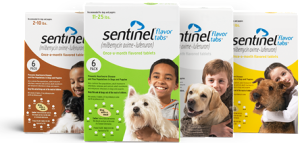
- What does it kill? Heartworm preventative and also prevents development of flea eggs; also kills adult hookworms, whipworms, and roundworms; Spectrum also praziquantel, which also treats tapeworms
- Route: Oral
- How long does it last for? It works for 30 days
- Active ingredient: Lufenuron and milbemycin oxime
- How does it work? Milbemycin: Activates nicotinic acetylcholine receptors and binds to glutamate-gated chloride ion channels; Lufenuron: a flea “birth control” that works by breaking the flea cycle and inhibiting the normal development of flea eggs; prevents most flea eggs from being able to hatch and mature into adults. Sentinel Spectrum also contains a dewormer praziquantel, which kills tapeworms
- How effective is it?
- How do you apply it? Orally (with food)
- Pros: Heartworm preventative (so you don’t need to buy additional medications); lasts one month; no oily medication applied to skin; acts as a very safe “birth control” against fleas. Must be used for > 6 months after the last exposure to mosquitoes to provide complete protection to heartworm (as a preventative); IMO, I use heartworm preventative year round for my dog to minimal all risk! Can be used in MDR-gene mutation dogs (e.g., Collies, etc.)
- Cons: Does not kill adult fleas; does not kill ticks; if you have an adult flea infestation (if you see fleas on your dog), won’t work alone – must be used with another medication that kills adult fleas quickly (e.g., Capstar, etc.)
- When you shouldn’t use it (Called “Contraindications”):Special NOTE: dogs must be tested for heartworm prior to administering, as mild hypersensitivity reactions can be seen from heartworm positive dogs
- Availability: Only by your veterinarian
- Made by: Virbac Animal Health
- More information can be found here: http://www.sentinelpet.com/about
Seresto 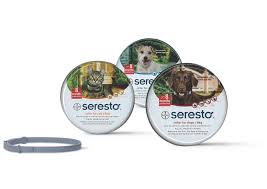
- What does it kill? Repels and kills adult fleas and ticks (Deer tick, American dog tick, brown dog tick, and lone star ticks) on dogs and cats; also kills chewing lice for 1 month.
- Route: Collar
- How long does it last for? 8 months
- Active ingredient: Imidacloprid and flumethrin (permethrin)
- How does it work? Imidacloprid acts like nicotine and disrupts the nervous system of the insect; flumethrin is in the pyrethrin class of drugs – permethrin is a chemical that affects the sodium channels in the neurologic system of the insect
- How effective is it? Prevents tick infestations within 48 hours of application; re-infesting ticks are repelled and/or killed as quickly as 6 hours; kills fleas within 24 hours; re-infesting fleas are filled within 2 hours
- How do you apply it? Topical collar
- Pros: Kills fleas and ticks and has a repellant also; long-acting topical collar so no oily medication applied to skin; “water proof” (well, kind of – if your dog is bathed or swims more than 1X/month… reduced efficacy); approved for dogs > 7 weeks of age; the cat version is approved for cats > 10 weeks of age.
- Cons: Requires wearing a chemical collar for 8 months; can result in accidental secondary exposure with close contact (e.g., sleeping with dog); slight skin reaction and hair loss can develop at area of collar placement; if your dog swims or is bathed more than 1X/month, efficacy is reduced from 8 months to 5 months. Imidacloprid is a neonicotinoid, and has been associated with killing bees in the environment (when used for crop dusting, etc.), so I prefer not to use it for environmental reasons, personally (but I’m crunchy and eco-friendly that way). You can read more about it from the EPA here and by Mother Jones here.
- When you shouldn’t use it (Called “Contraindications”): Any known sensitivity to the 2 ingredients
- Availability: Only by your veterinarian
- Made by: Bayer Animal Health
- More information can be found here: http://www.petparents.com/products.aspx/index/seresto?WHGRedir=1
Simparca 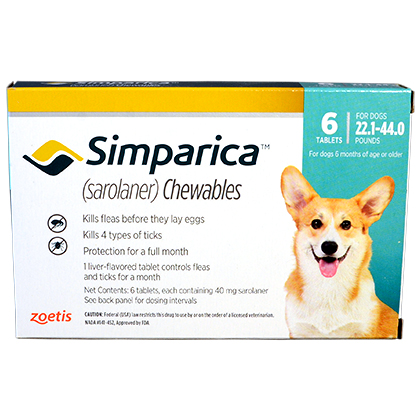
- What does it kill? Kills adult fleas and ticks [Ixodes scapularis (deer tick or black-legged tick), Amblyomma americanum (Lone Star tick), Amblyomma maculatum (Gulf Coast tick), Dermacentor variabilis (American dog tick), and Rhipicephalus sanguineus (brown dog tick)]
- Route: Oral
- How long does it last for? 1 month
- Active ingredient: Sarolaner
- How does it work? Sarolaner is a chemical in the isoxazoline group, which inhibits the function of the neurotransmitter gamma aminobutyric acid (GABA) receptor and glutamate receptor in insects (fleas) and acarines (ticks). This leads to uncontrolled neuromuscular activity leading to death.
- How effective is it? Kills ticks within 8 hours and is ≥96.9% effective for 35 days
- How do you apply it? Orally once a month
- Pros: Kills ticks within 8 hours and is ≥96.9% effective for 35 days; for dogs > 6 months of age
- Cons: Hasn’t been evaluated in dogs that are pregnant, breeding or lactating, shouldn’t be used in dogs with seizures. Simparica may cause abnormal neurologic signs such as tremors, unsteadiness, and/or seizures
- When you shouldn’t use it (Called “Contraindications”): Any known sensitivity to the ingredient; Simparica may cause abnormal neurologic signs such as tremors, unsteadiness, and/or seizures. Simparica has not been evaluated in dogs that are pregnant, breeding or lactating. Simparica has been safely used in dogs treated with commonly prescribed vaccines, parasiticides and other medications. The most frequently reported adverse reactions were vomiting and diarrhea. See full Prescribing Information.
- Availability: Only by your veterinarian, for dogs > 6 months
- Made by: Zoetis
- More information can be found HERE
Simparca Trio
- What does it kill? Kills adult fleas (Ctenocephalides felis) and ticks [Ixodes scapularis (deer tick or black-legged tick), Amblyomma americanum (Lone Star tick), Amblyomma maculatum (Gulf Coast tick), Dermacentor variabilis (American dog tick), and Rhipicephalus sanguineus (brown dog tick)], along with roundworms, hookwoods, and prevention against heartworm disease.
- Route: Oral
- How long does it last for? 1 month
- Active ingredient: Sarolaner, moxidectin and pyrantel
- How does it work? Sarolaner is a chemical in the isoxazoline group, which inhibits the function of the neurotransmitter gamma aminobutyric acid (GABA) receptor and glutamate receptor in insects (fleas) and acarines (ticks). This leads to uncontrolled neuromuscular activity leading to death. Moxidectin, which is in the class of macrocyclic lactone drugs, affects chloride ion channel activity in the nervous system of insects.
- How effective is it? Simparica Trio begins to kill adult fleas within 3 hours and ticks within 8 hours of administration and is ≥96.9% effective for 35 days.
- How do you apply it? Orally once a month
- Pros: Kills ticks within 8 hours and is ≥96.9% effective for 35 days; for dogs > 6 months of age
- Cons: Hasn’t been evaluated in dogs that are pregnant, breeding or lactating, shouldn’t be used in dogs with seizures. Simparica may cause abnormal neurologic signs such as tremors, unsteadiness, and/or seizures
- When you shouldn’t use it (Called “Contraindications”): Any known sensitivity to the ingredient; Simparica Trio may cause abnormal neurologic signs such as tremors, unsteadiness, and/or seizures. Simparica has not been evaluated in dogs that are pregnant, breeding or lactating. Simparica has been safely used in dogs treated with commonly prescribed vaccines, parasiticides and other medications. The most frequently reported adverse reactions were vomiting and diarrhea. See full Prescribing Information.
- Availability: Only by your veterinarian, for dogs > 8 weeks of age and > 2.8 pounds
- Made by: Zoetis
- More information can be found HERE
Trifexis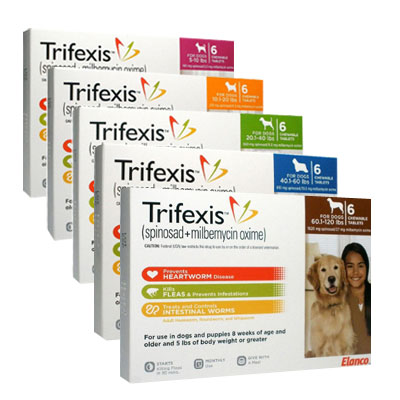
- What does it kill? Heartworm preventative and also kills fleas on dogs; also kills hookworm, roundworm, and whipworm
- Route: Oral
- How long does it last for? It works for 30 days
- Active ingredient: Spinosad and milbemycin oxime
- How does it work? Activates nicotinic acetylcholine receptors and binds to glutamate-gated chloride ion channels
- How effective is it? Kills >98% of fleas in 4 hours for 1 month; killing of fleas starts within 30 minutes; 100% effective as a heartworm preventative when given for a minimum of 3 consecutive monthly doses
- How do you apply it? Orally (with food)
- Pros: Kills fleas quickly and has the added benefit of being a heartworm preventative (so you don’t need to buy additional medications); lasts one month; high efficacy and fast kill for fleas; kills fleas before they can lay eggs; no oily medication applied to skin
- Cons: Not for use in cats; doesn’t kill ticks; can see vomiting with it (ideally observe your dog for 1 hour after giving; if vomiting occurs with an hour, re-dose with another full dose – Elanco often will reimburse you for this extra dose through your veterinarian, FYI); is not labelled for pregnant, lactating or breeding animals
- When you shouldn’t use it (Called “Contraindications”): Should not be used if your dog is on high-dose ivermectin (a medication for demodex/mange); in dogs with a history of seizures. Special NOTE: dogs must be tested for heartworm prior to administering, as reactions can be seen from heartworm positive dogs; also, use in caution in breeding females
- Availability: Only by your veterinarian
- Made by: Elanco Animal Health
- More information can be found here: http://www.trifexis.com/
Vectra 3D 
- What does it kill? Kills and repels fleas, ticks, mosquitoes, lice, mites, sand and biting flies for dogs only
- Route: Topical spot-on
- How long does it last for? Lasts 1 month
- Active ingredient: High concentration permethrin (58%), dinotefuran (4.95%), and pyriproxyfen (0.44%), a potent insect juvenile hormone that affects normal development of flea development
- How does it work? Permethrin, which is a chemical that affects the sodium channels in the neurologic system of the insect; dinotefuran, a neonicotonoid which affects the neurologic system of the insect; pyriproxyfen (0.44%), a potent insect juvenile hormone that affects normal development of flea development.
- How effective is it? Kills fleas as early as 2 hours; in dogs, kills 96% of fleas within 6 hours.
- How do you apply it? Topically onto the skin, waterproof
- Pros: Kills fleas and ticks quickly; provides a repellant in addition to killing insects; does not require insects to bite to die; waterproof; approved for dogs > 7 weeks and 2.5 pounds
- Cons: If accidentally applied to a cat, can result in life-threatening seizures, tremors and death; can result in an adverse reaction called parasthesia (e.g., intense tingling/stinging sensation) and secondary trauma to the site of application in dogs; with dogs and cats living together, cats should be separated from dogs until the product is completely dried on the dog; IMO, neonicotinoids are associated with death of bees so I personally don’t use this type of insecticide
- When you shouldn’t use it (Called “Contraindications”): As this dog product contains a high concentration pyrethrin, it should NEVER be used in cats!
- Availability: At your veterinarian
- Made by: Ceva Animal Health
- More information can be found here: http://www.vectrapet.com/
- NOTE: The product made specificially for cats (not 3D) does not contain permethrin (only contains dinetofuran and pyriproxyfen) and can be safely used on cats > 8 weeks and > 2 pounds.

Photo by Lee Haywood // cc
Regardless of which flea and tick medication you pick, please make sure to do the following to keep your pet healthy:
- Check with your veterinarian.
- Weigh your pet before you administer the flea and tick medication to confirm appropriate dosing!
- Read the directions carefully – don’t put dog product on a cat ever!
- Make sure not to let your dog go swimming (or bathed) within a few days before or after application of a topical (it kills fish, poisons the environment, reduces efficacy of the product, etc.)
- If your dog or cat is old, debilitated or has underlying medical problems – or very young – please make sure to check with your veterinarian before administering any medication!
- Make sure to use the product during flea and tick season – in Minnesota, that starts in April and ends when there is a hard frost (e.g., October)
- Implement flea-killing techniques (e.g., apply the product appropriately but also wash all the bedding, make sure ALL the pets in the house are treated, vacuum daily, etc.)
See any misinformation or missing info? Let me know! What other hints or experiences have you had?

Legal mumbo-jumbo:
When in doubt, check with your veterinarian or with the manufacturer (by just calling the toll-free number on the box). Please note that the views and medical opinions expressed on these webpages are the expressed opinion of Dr. Justine Lee, DACVECC, DABT. Medical information here should be referenced by the practitioner or pet owner prior to use. Under no circumstances shall Dr. Justine Lee be liable for any loss, damage, liability or expense incurred or suffered that is claimed to have resulted from the use of the information provided including, without limitation, any fault, error, omission, interruption or delay with respect thereto. If you have any questions regarding the information provided, please contact Dr. Justine Lee.


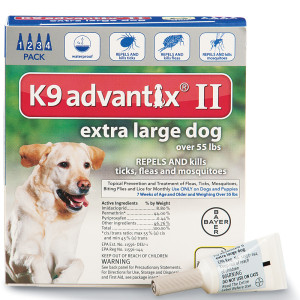

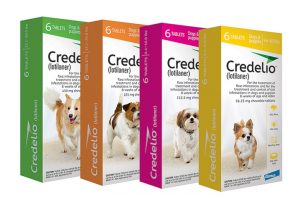
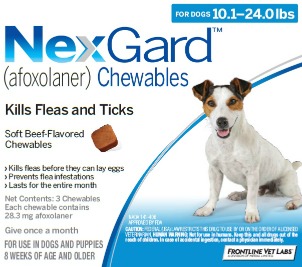
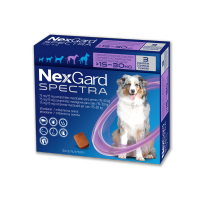
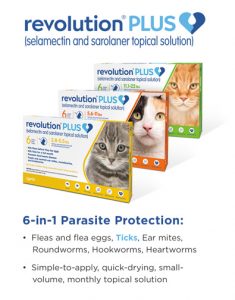
Hi Dr Lee,
Wow! Thanks for this information…a lot of choices out there, and it is great to see it set forth in detailed, easy to read format!
Question: Does the Bravecto product also work on deer ticks? I didn’t see it listed, but saw deer ticks cited for other products you noted.
Thanks,
-Roxanne
Yes, deer ticks are definitely killed by Bravecto!
Can you use a topical flea prevention, with an oral? I gave my 5 month old Labrador, Credelio, and he still got flea bites. Can I put topical Revolution on him, as well?
You can, but you might have fleas in the environment that keep biting, so make sure to vaccuum every day, make sure all the other house pets are on flea and tick medication, and talk to your vet!
Any idea if the active ingredient in Bravecto is harmful to the environment or wildlife?
Great question – no, not that I know of. It is mostly fecally eliminated, and doesn’t kill bees directly like others.
Hi Dr Lee,
What about Nexgard? Does Nexgard also work on deer ticks? I didn’t see it listed but saw deer ticks cited for the other products you noted.
Thanks,
Trish
It gets Ixodes – the one from Europe was tested, but it appears to be effective against American deer ticks too.
Thank you for this informative list! Can the Seresto collar be used in conjunction with Trifexis for dogs and Comfortis for cats? I don’t want to overdose my fur babies, but we are about to have a newborn grandbaby in the house and can’t have fleas. Our animals are all indoor/outdoor. Thanks!
I’m not a huge fan of the Seresto collar if your newborn lies on your dogs and cats if there’s secondary contact (e.g., don’t have the collar rubbing on a human). Talk to your vet to check!
Hi, I have an 11 year old Diabetic poodle, will Trifexis hurt her? Is it safe for her kidneys and liver? She is on novolin insulin 2x day. Thanks.
It is safe but I would talk to your veterinarian. It shouldn’t be used if your dog is on high-dose ivermectin (a dewormer).
I have a elderly cat almost 16 years old. He is in the early stages of renal failure. We have always used Frontline Topical but about 6 months ago they changed up their formula and since then he scratches all the time. I am looking for a new flea & tick topical. A friend of mine recommended the Braveto which sounds great! But when I talked to my vet about it, she told me to research the side effects etc. I haven’t found anything that looks too bad about it?? Any suggestions?
Great question. I’ve never used it in cats but it’s topical. I usually use Advantage in cats BUT not ADVANTIX (which is poisonous). Check with your vet to be safe.
seresto almost killed my Min Pins do you think comfortis would be a good choice to try?
I would talk to your veterinarian to be safe. That’s weird about Seresto, as it’s a high concentration pyrethrin, so be safe and ask your veterinarian. Comfortis does have a wide margin of safety. Also, if your dog is exposed to ticks, you will still need tick control.
My 1-yr old cat has been getting tapeworms roughly every 3-4 months. He’s a strictly indoor cat, and I have never seen a flea on him (he’s white so it’s relatively easy to search) but I understand tapeworms come from fleas. The vet said maybe we are tracking fleas into the house, or maybe there are dormant flea eggs that are hatching. I have no clue. Anyway, the vet said to put the cat on Cheristin, which I did. But Cheristin has an extremely strong odor that smells kind of like kerosene or some other toxic chemical. I know it’s not toxic, but I’m floored by how nasty it smells. And the cat is absolutely miserable with it on. All he wants to do is get it off (which he can’t because I apply it correctly). It’s so bad he just hides for 2 days and I can’t even really pet him for 3-4 days. My question is: are all of the topical flea products this way? Is there one that is less offensive than the others? Thank you.
Oh no – I’m so sorry to hear that. Unfortunately, you definitely have fleas in the house if he has tapeworms. 🙁 I use Advantage (NOT Advantix) on my cats, so that’s an option. Otherwise, you can try Revolution too. I’ve never used Cheristin before – sorry!
Hi! My 5 year old rescue dog is Heartworm positive and on overheat max. Is it safe to give him be hard for flea and tick treatment?
Which heartworm medication?
I am not a vet, so my answer is not to be taken as law, but I had a mastiff that was positive for heartworms for years and we were told she would be fine. she also had a slight heart murmur. she lived for 4 more years before bone cancer took her. I wish you all the best God Bless just make sure to consult your vet, they may tell you to continue the heartworm treatment anyway because there are other types of worms they can get.
I’m looking for a cat-safe topical product that kills deer ticks (also called black legged ticks). These are the ticks that carry Lyme disease. The only product on your list that matches this description is Frontline Plus. But the comment under Cons states “kills ticks slowly as compared to new medications where diseases can potentially be transmitted in the 24-48 hour window”. What new medications is this comment referencing?
Frontline kills ticks, but over 24-48 hours. I would talk to your vet about a faster killing flea and tick medication. You can use topical Bravecto for cats too. The biggest thing is NOT to use high concentration pyrethrins, however!
I have placed frontline plus on dog on 10-11-17. One week later ORKIN sprayed entire house amd we treated outside. Also using cap star as I see fleas on dog daily. Can I reapply frontline plus at the two week mark instead of waiting as I am still seeing fleas on dog. Orrin will be back two weeks from first application.
I would talk to your veterinarian about using something that kills quickly. Unfortunately, there sounds like there’s a major flea infestation and you need to vacuum DAILY as the flea eggs are hatching, which is what is causing the constant infestation. One flea produces 40+ eggs, and they hatch constantly.
Use a garlic supplement or raw garlic for flea and tick control. Dosage for raw garlic is 1 tsp for every 30 lbs, 1x day. Chop up garlic and let it sit for 10 min to allow the medicinal ingredients to release. This is far safer that all those tick and flea poisons.
Unfortunately, that dose is highly poisonous to cats and potentially to dogs. It’s been proven in studies that Allium sp is not safe for pets.
This is a great article! I had a question for you. we are pregnant (as in me and not our dog ) 🙂 And I’ve used Bravecto in the past with great success but have been hesitant to use since we got pregnant – due in March. Is there anything to worry about in regards to using this prodcut on our dog as we sleep *cuddle* 🙂 with him at night… I cant’ find any info on it!
Thank you!
Great question – I also was pregnant and had no problem medicating my dog with Bravecto. I would be MORE worried using a topical flea and tick product or collar if you were pregnant due to closer contact with the chemicals. But when in doubt, contact your medical doctor or OB-GYN to be safe.
Just a suggestion because you guys are pregnant and looking for a family safe resolution. I have a mini pig and need something for ticks when we got him. There is a product it can be found at feed stores like tractor supply, Walmart, and online at chewy.com. Just make sure it reads (food grade) like this, Diatomaceous Earth Food Grade Powder. It can be put right in your pet’s food bowl and can also be spread around the inside and outside perimeter of your home to keep out ticks, and other insects like ants,spiders, etc. It is a very fine powder so a little goes a very very long way, and MOST important it is safe to humans and pets. I have used it for both my dogs and pig for years now. Its not easy to get the powder spread in the house, but I have used it in the electrical sockets where we had serious issues with ants after hurricanes and in the back perimeter of our yard where we were surrounded by woods and I feared deer ticks because my piggy loved the tree line. Wishing the best for you ladies and your pregnancies . God Bless
What would you recommend for a cat with sensitivity? He is 7 years old, 15 lbs and Advantage burned his hair off. He’s been having skin issues (excessive licking). I’m on my 3rd vet who has told me that cats groom so well metimes you not see the fleas. I want to treat him but I don’t know what I use.
Revolution works really well but there are lots of options out there. Advantage caused hair loss on my Cat too, but don’t worry – it’s not “burning it” off. Is your cat indoor or outdoor?
Excessive licking is also a sign of food allergies and it would be worth consulting with a veterinary dermatologist.
What about Provecta? Can you tell us about this product?
For dogs or cats? For dogs, it’s very similar to Advantix as it contains: imidacloprid, permethrin and pyriproxyfen, an insect growth regulator (IGR). Very safe in dogs BUT not cats. It’s got a high concentration pyrethrin which can rarely cause topical irritation (paresthesia) to the skin area.
Hello,
Ive been told by a vet office that Cheristin works great for ear mites, but I am unable to find any confirmatuon of that anywhere online.
Why do you think the Vets office suggested Cheristin for my cats ear mites but there’s nothing in the literature.? Is it possible that flea treatments work just as well for ear mite treatment?
Hi, I’m honestly not sure as I haven’t ever used that product. It’s labeled for fleas. A lot of these flea and tick medications often do have “extra label” uses (e.g., they can kill other insects). I would call the company directly to ask (I believe it’s Elanco)?
Can I dose my cat with Capstar 2 weeks after administering frontline gold?
Yes, both are very safe. More importantly, implement aggressive flea control like vacuuming daily and throwing away the bag every day, washing the cat beds, blankets, etc. Good luck!
Thank you so much. I am vacuuming daily and washing bedding. And my outside cat is now an inside cat forever!
Thank you for this article. Our 3 year collie/poodle has been having seizures (4 in the last 7 months). After many tests, he has been diagnosed with epilepsy. We’ve had him on Nexguard and now I’m concerned that it might be dangerous for him. I’m desperately searching for a good flea and tick medicine. Our vet said Nexguard was/is okay for him, but I don’t want to take any chances. Can you please help? We live in Knoxville, TN and spend a lot of time in the mountains and at the lake. I’m desperate…His seizures are so heartbreaking! Thanks!
My dogs agree with yours- Nexgard is less than tasty. I would rather have a small pill to give them than to have to watch like a hawk to make sure they eat the whole thing. (Plus guarding them from the less fussy chowhounds!) That said, Nexgard has worked very well for us.
Sal, I just got a seresto collar for my dog. You said you wanted to go back to the seresto so I wanted to ask if you had a good experience using it.
Wow, very interesting! Thanks
I have used Bravecto 2 weeks ago (so really at the beginning of the 3-month period) but I am really unsatisfied. The poor dog is still full with ticks (alive and dead). Those biting him die fast, but the other are crawling around for hours before dying. I found then one on my son, who was caressing the dog. I am very worried. I am thinking about start using Seresto again. But how long should I wait? Any info regarding interactions between the different active ingredients?
Thanks!
I’m sorry to hear that. These are two totally unrelated active ingredients, and should be totally fine for you to use together. But when in doubt, talk to your vet about this.
Is it safe to combine Sentinel with a topical fipronil? We live in an area with lots of fleas and ticks but don’t have a problem with our four dogs…yet.
Yes, but Sentinel is also a heartworm medication and your dog must be heartworm negative before starting this. I’d talk to your veterinarian to be on the safe side! Sentinel also contains lufenuron which doesn’t kill adult fleas or ticks – it’s a birth preventative-type of medication preventing flea eggs from hatching.
Do you have a recommendation for a brand/type of yard spray or granules to use around the perimeter of our yard, which backs up onto a woods? If you don’t feel comfortable with a brand, just the ingredients to use or avoid? Deer ticks are our concern here. We have removed brush, etc, and created a barrier. Neighbor’s dog has Lyme disease.
Hi! Good job – you can see some good recommendations here from the CDC:
https://www.cdc.gov/lyme/prev/in_the_yard.html
Honestly, it’s still safer to use a fast acting tick kill like the oral flea and ticks instead. The CDC also lists some natural ones here:
https://www.cdc.gov/lyme/prev/natural-repellents.html
but I haven’t found those to work as well.
Backyard chickens? They really cut down on ticks!
Information on bravecto is not correct. It is available for cats:
https://us.bravecto.com/for-cats.aspx?&gclid=EAIaIQobChMI0MPngdTx2gIVybjACh3BCgGzEAAYASAAEgJ79vD_BwE&gclsrc=aw.ds
Thanks! Updated!
Too many choices of flea & tick treatments. We live in tick-infested Connecticut, and (until now) I’ve only applied topical Vectra 3D to my 6 yr old dog (every 30 days). For the first few hours after application it drives her nuts but then she’s ok and it definitely works. With so many newly introduced flea & tick meds over the past few years it’s not clear if I should stick with tried & true or go with another option.
If you’re having success with it and not seeing any ticks or fleas on your dog, than that’s great! It’s a high concentration pyrethrin.
Hi there! Any comparable info on Parastar? Also, Credelio is spelled incorrectly, but no biggie! I recommend pet owners to this comparison so much, thank you for compiling this!
Also I have several owners asking about “Wondercide” products, wondering your view? I haven’t found much data on efficacy.
Thanks so much for writing – spelling corrected! Unfortunately, the toxicologist in me is going to say that Wondercide doesn’t work well – it’s all essential oils, and these do NOT have high efficacy for killing fleas and ticks. To me, it’s NEVER worth the risk of having even one flea come into the house, as it’s a nightmare to deal with (as they lay 400 eggs!). As for Parastar Plus, it contains fipronil/cyphenothrin which are both very effective – but one is a pyrethrin and shouldn’t be used on cats. As for Parastar (not the Plus), it’s only fipronil, and I think we’re seeing increased resistance to that, personally. So I don’t think it should be used ALONE.
Is there any secondary exposure risk to humans from properly handled bravecto given to dogs that love to kiss their people a lot?
One dog with history of multiple benign cancer growths, another with history of cystine stones and pancreatitus and another with history of allergies and on apoquel.
Are there any contraindications if dog needs sedation/anesthesia and surgery?
Great question – no, very little risk. I handled it even when I was pregnant, as it’s for seconds and not absorbed across skin contact like that (that quickly). The other problems you describe are very common problems unfortunately in older dogs (with miniature Schnazuers coming to mind!). No contraindications that I know of with anesthesia or surgery. The biggest contraindication would be if your dog has a seizure history!
Does Bravecto protect against hookworm infestation? My dogs take Bravecto for fleas and ticks, and they take Heart Pro shots for heart worms. Are they protected from hookworms?
Bravecto vs seresto vs advantix ? And why pleaese
For my young healthy knaan dog
Great question – total personal preference but I would ask your vet too. If your dog sleeps with you or your children, I prefer not to use a topical or collar, so there’s no secondary exposure. That said, check with your vet – they are all very effective and safe!
Comment
I recently read information about the risks of using Bravecto. Have you seen any new information about it? What is your opinion?
I honestly haven’t heard anything re: this? I use it in my own dog, FYI.
I did not see a review for Intercepter used for heartworm prevention. Your thoughts on it? Thanks
It is also excellent and well established in veterinary medicine!
i have a yorkie with a liver shunt, I have been using the bravecto but it seems to make him sick for about a week after giving it to him. Whatdo you receommend for a liver shunt dog as far as flea and tick medicine?
I would ask your veterinarian to check as with a liver shunt, drugs aren’t metabolized normally!
I have a chipom who is on medications for mitral valve disease and failure….new kitten brought fleas into the house and now we’ve got a mess. My question is my dog is now treated with frontline and had a flea bath…can I give her capstar? I’m worried about her anemia.
Yes, check with your veterinarian, but Capstar is very safe and fast acting.
is is safe for Australian Shepherd 5 years old female take Sarolaner Chewables? is it safe for her breed? thanks
Yes, it is – but check with your veterinarian. You can find the Freedom of Information act on it and the pertinent info here:
Acute Toxicity and Tolerance of Sarolaner
LD50 acute, rats, p.o. 783 mg/kg
LD50 acute, rats, dermal >2020 mg/kg.
In repeat-dose toxicity studies in rats, the target organs are the adrenal glands, liver and ovaries.
NOAEL (No observed adverse effect level) in rats: 0.233 mg/kg/day in the 30 days study; 0.25 mg/kg/day in the 90 day study. In rats, gross enlargement of the adrenal glands at 22.33 mg/kg/day in males and female was related to higher adrenal gland weights and microscopic hypertrophy of zona fasciculata cells of the adrenal cortex. At 2.233 mg/kg/day effects on the liver were observed (dose dependent vacuolation in females accompanied by decreased triglyceride levels in blood). Moreover, vacuolation in the adrenal gland was observed in males and adrenal gland weights were increased in females. Also (dose dependent) histopathological changes were observed in the ovary.
In dogs neurological effects were noted at doses of 20 mg/kg (convulsions, tremors and ataxia) and 12 mg/kg (tremors, ataxia). Signs appeared to occur primarily in the first 24 hours after dosing and resolved without treatment. No effects on the nervous system were observed in any animal at 4 mg/kg.
Prenatal developmental toxicity studies have not shown any teratogenic effects, but studies of the effects on reproduction were not provided. Sarolaner is not genotoxic and no carcinogenicity studies were carried out.
Sarolaner is well tolerated in Collies with a deficient multidrug-resistance-protein 1 (MDR1 -/-) following single oral administration at 5 times the recommended dose. No treatment-related clinical signs were observed. Such dogs are particularly susceptible to treatment with macrocyclic lactones (e.g. ivermectin, milbemycin oxime, moxidectin, selamectin, etc.)
K9 Advantix made my 50 pound lab nutty for two days. Jittery, stopping to scratch in an odd manner. She wasn’t herself for at least two days. The dose said 21-50. What would it do to her if she were 20 pounds. I do not recommend!
Oh no! When in doubt, call the 800 # on the box immediately. It sounds like your dog had an adverse reaction – rarely, high concentration pyrethrins cause intense tingling when applied to dogs – if this happens, it should be washed off IMMEDIATELY with a liquid dish soap like Dawn (used to wash dishes in the sink). It’s called paresthesia. You can also apply a cool compress to the area after bathing it off and then open up an oral Vitamin E capsule and spread the oil over the site. That may help! When in doubt, contact your veterinarian about which type of flea and tick medication to use.
I saw on the news that dogs were having side effects with Bravecto, Nexguard and Simparica. There is an ingredient isooxazoline that gives the dog diarrhea, vomiting, neurological symptom’s etc…..
My dog does better with a chewable any recommendations?
Great question – I’m glad the FDA reported this but these side effects are rare – that said, as a veterinarian, I wouldn’t recommend oral flea and tick medications personally for any dog that has a history of epilepsy or seizures. I use these in my own dog, FYI.
Hi!
Thank you so much for the well written article but alas it has left me with further questions since leaving our own vet today.
We switched from Revolution to Bravecto(I’d not heard of it until today). I’m happy we did as nobody mentioned that it doesn’t encompass multiple ticks and geographically that is a huge factor in our protection.
With Revolution we ceased dewormer (Strongid) on our vets recommendation but now that we’re off the revolution should we add a dewormer back in in the spring and fall or some other secondary protection? We live on the East Coast of Canada.
Is your dog on heartworm preventative too? If so, that typically has a dewormer in it. If your dog isn’t on a heartworm preventative, I would recommend twice a year deworming.
Does Bravecto prevent flea infestation as well as killing them? I am trying to decide between Bravecto and Seresto
The additional benefit of Seresto is that it has a repellant, but doesn’t have a “preventative.” Neither of them have a flea birth control, but they are so fast killing, it shouldn’t be an issue with fleas with either product!
I am trying to decide between Bravecto and Seresto.Does either repell reinvesting fleas as well as killing the ones already on the dog?
My 3 large dogs are on Sentinel Spectrum and Simparica. Is it really necessary from them to take both? I read some scary things about Simparica a while back and I just had my annual sticker shock picking up their meds (Simparica runs me $500+ a year). From what I can see the only additional protection Simparica gives is for ticks? I live in urban Houston and I’ve yet to come across a tick here/on my dogs.
Great question – yes, if you live in a tick infested area, you do need tick coverage. The Sentinel has NO tick coverage. Also, Sentinel is mostly for heartworm, general deworming and has a flea birth-control like product, but doesn’t kill adult fleas, so I would talk to your vet about. The Simparica does get both fleas and ticks!
I gave my 45 pound dog 1/2 dose of K9Avantix II for large dogs topically 2 weeks ago. I need to leave him with a petsitter in a high tick infested area. can I give him an oral Nexgard?
It’s safe to use these orals and topicals together in general, but when in doubt, check with your veterinarian.
Great Pyreneese (100 lbs) is on Revolution. Found a tick on him. Vet gave me NexGard. They suggested he be tested for Lymes Disease in 4-6 weeks. Dog is on both meds. Should I continue giving him Revolution and NexGard? Seems like an awful lot of meds.
Great question – the Revolution is needed for heartworm protection. It does also get fleas and limited ticks. I would check with your vet!
Wow. None of these products sound truly safe for our dog or for the environment. It’s more like choosing from the least dangerous option. There simply has to be another way!
I’ve been using Advantage II for a while now and it used to work great!
But the past couple months I’ve seen that it’s not working anymore…
A friend recommended Seresto collars but I see here that they both use Imidacloprid.
So I’m wondering, since the drops with Imidacloprid stopped working, would the collars not work either?
I don’t want to buy these expensive collars if they aren’t going to work.
Thank you for your input! 🙂
I want to use bravecto but my dog is only 3 months. Our vet only have comfortus. This won’t help with ticks. We call alot. What can I use in addition to comfortis go ticks?
That’s so frustrating! You can ask if it can be used extra-label. It’s b/c your puppy is still growing so the weight is very variable until about 6 months of age. You can consider a Preventic collar, Seresto collar, Simparica, etc.
I’ve been using Advantage II for a while now and it used to work great!
But the past couple months I’ve seen that it’s not working anymore…
A friend recommended Seresto collars but I see here that they both use Imidacloprid.
So I’m wondering, since the drops with Imidacloprid stopped working, would the collars not work either?
I don’t want to buy these expensive collars if they aren’t going to work.
Thank you for your input! 🙂
It has other added ingredients such as pyrethrins in the Seresto collar too, and I’ve heard colleagues have good success with it.
I have three large dogs and we’ve used Advantix II on them in the past. We live in NC where fleas are awful and ticks are everpresent. They are indoor-outdoor dogs so they need coverage for both creatures. I’ve noticed that gnats will fly around my dogs (eyes, genitals) and my dogs are still itching even two weeks after applying. We seem to get about three weeks of use out of a dose of Advantix II. Is there something different that I can use that will help with the itching, fleas, ticks, and gnats? We have two small kids that love to cuddle with the dogs so I’m less than excited about using a topical. Bravecto and Nexgard have caught my eye .
A Seresto collar will help with repellancy for gnats and mosquitos, but with kids cuddling, I prefer oral. I personally use Bravecto in my dog every 3 months.
This is an extremely informative article – thanks for the information. I have an 8 year old Std.Poodle that I use Advantage-Multi for heart worm and flea control, and two weeks after applying it, I apply Advantix II for tick and flea control. I have had no problems with these 2 products in him. I have a new std poodle puppy (12 weeks old) and want to know if this combination would be acceptable for her. I am asking this since I started the combination of the 2 products in my older dog when he was an adult.
You can but it’s a lot more than you need. If you’re having success with it and no problems, I’d continue or check with your vet. I’m not a huge fan of topicals as I have cats do prefer oral but the topicals are safe (in dogs).
need flea a and tiock meds
I switched my dog from Trifexis to a Heartgard/Nexgard combo, but my vet told me there would be no problem just changing the medication once my box of Trifexis was gone. Even though I’m reading Trifexis has Spinosad and the Heartgard has Ivermectin. I didn’t use them together, but changed from one to the other. Should there have been been a waiting period before starting a new medicine? (I waited the 30 days until he was due again)
It typically isn’t an issue – there are rare complications with using spinosad with high dose ivermectin, but the amount in Heartgard is very low and safe. But when in doubt, please call your vet or the company to confirm!
Hi Dr. Lee. Thanks for this informative article. One question. Are you familiar with Paradyne for cats? Does it have good efficacy versus Revolution? Thanks.
My previous dog (a cockapoo) had occasional seizures and I was always nervous giving her K9 Advantix. Sadly we lost her last May (not due to seizures) and now we have a 7 months old puppy. The vet gave me Provecta topical which I have used twice and so far no seizures. He is also on Tri-Heart Plus. I usually buy my meds through petmeds because they are a lot cheaper but my vet said that some of these online providers don’t use certified meds. Two questions, is it OK to buy online and what do you think of Provecta vs. K9 Advantix or another topical flea and tick product. Thanks in advance.
Best information available on the web regarding flea control. I should have done research prior to administering an item. I decided to use Hartz flea and tick topical because the company has been around for years. However, I stumbled upon reviews claiming that this item is harmful to dogs and now I’m alarmed with worry. I’m sure it’ll be okay, but what are your thoughts on the controversial reviews and the chemical used in this product? Any feedback will be appreciated.
Great question – it’s very safe for dogs and is effective if it’s a high concentration pyrethrin (which it typically is – just check the ingredient). A high concentration pyrethrin will typically end with a “thrin” at the end of the ingredient (Don’t worry about the inert ingredients). Do NOT apply this on cats though!
What about Nexgard Spectrum? Could I ask, which kind of medication/treatment do you use currently for your Dogs?
What kind of treatment do you use currently for your Dogs?
I started with Nexgard and then changed to Bravecto. Great question. I always say, do what your vet would do! All of these flea and tick medications are generally safe; there are rare adverse effects seen, so you do need to be aware (e.g., seizure history, etc.).
Hi! This article is SO helpful! We currently give Simparica and Heartgard to our dog. Is there something we can do for mosquitos/gnats?
Also, we are getting a puppy and he will be 11 weeks. We live in rural MN, so we would like to put him on a flea/tick ASAP. What’s best for a puppy? (I don’t think he can take Simparica until 6 months).
Thank you!
Thanks Ashley! I live in the Twin Cities and we are SEVERELY tick infested, so I like any oral medication with a FAST kill on ticks. You can use some of the orals on puppies (e.g., Nexgard, etc.) and once they are > 6 months (and big enough size), then switch to the longer acting ones. For mosquitoes and gnats, I believe that Advantix and the Seresto collar gets them but would confirm with your vet (or the Bayer Animal Health website). Hope that helps!
My 17 pound mixed breed rescue hates to have Advantix applied to her. She will squirm, hide etc. Afterward she seems a little depressed and it lasts for a day. Is this something to worry about? She due to have it applied today but we moved and we don’t see our new vet for two weeks. Thanks!
Yes! She may be having a rare adverse effect from it where it’s causing “parasthesia” and intense itching at the site – I would call the 800# on the back of the product or contact your vet for other options!
After final monthly dose of Trifexis, can Revolution be administered the following Monday th?
Yes this should be fine but when in doubt, check with your veterinarian.
If we use bravecto on our 4 dogs, should we be using ivermectin too?
Yes, but talk to your vet – the ivermectin is typically for HEARTWORM (Bravecto only gets fleas and ticks!).
My 8 lb Yorkie-Poodle mix tolerated the topical well (I believe Frontline) however vet switched to oral Simparica and he had a slight reaction the first time and that reaction grew increasingly more severe with each month’s dose. The reaction was twitching and staring in a trace like state very soon after dosing. The vet switched back to a topical but not positive about brand, I believe it was Nexgard. He had same reactions. It has been 2 years and he hasn’t had any type of tick medicine. I am concerned now because we Just moved to a very heavily wooded area in Eastern TN where ticks are much more prevalent. Is there an holistic or organic option? Should we try the Frontline again? What are your thoughts? Thank you for your help.
Nexgard isn’t a topical. In TN, you definitely need a strong tick preventative. Frontline can be used be has a slower kill, but still is effective.
Thanks Justine!
Leaning toward Brovector for the environmental (important) reasons you gave…. but Sorresto REPELS whereas Bravecto does not – and my puppy is only 4 months old….doesn’t like taking pills…HOPE she will eat/chew it…..
Thanks for the comparisons….they were great.
I was going to go with Soresto but also concerned re the possible environmental impacts
That being said, Bravecto doesn’t REPEL….but does kill quickly while Sorecto repels….
I do like that it is palatable…for a 4 month old puppy that does NOT like pills….are you sure she WILL chew it??? She’s getting pretty smart when I put it in her food……
Thank you again.
Recent sent this to my vet (per your disclaimer). Am wondering what your thoughts are on this & also if you have a favorite non-nicotine’s anti-parasite collar. Thanks!
“On my larger, long dogs, what are your thoughts on the safety/toxicity of using a Seresto collar (which I’d like to take off when they’re swimming) in addition to Frontline Plus on the rear half or 1/3 of the toros & tail?
Background info:
My 3 dogs (~89lbs, ~75lbs, ~29lbs) have been on Sentinel Spectrum & Frontline plus for years. The biggest one goes to daycare (likely not a 100% flea-free place). The two big ones are now frequently submerged in water for longish periods of time (30+ minutes of fetch/chase in Ocean waters 4-6x/wk in summer).
The few studies I’ve seen re: water resistance of Frontline are just resistance (eg showering q7ish days of laboratory dogs 🙁 ) do not really reflect how much my bigger dogs are in the water. None of the dogs are displaying unusual behavior indicating fleas but that doesn’t mean they don’t have a few, especially towards the end of the monthly Frontline cycle. I personally have 5-10 bites in places on my body that the dogs fall asleep on, that I’m 1000% certain are flea bites.”
If they truly swim that much, I’d recommend using an oral flea and tick instead.
My vet started testing for Lyme exposure since our previous visit, and my min poodle aged 5) showed as having late or chronic stage of infection/exposure. We are now waiting for results of uninalysis with sedment to check for kidney damage. He has no symptoms. Vet wants to start doxycyline for 4 weeks, just in case. I know that is controversial, and am concerned because I get upset stomach with the drug myself, and my poodle is already not a big eater. But that’s another issue.
We used to use Frontline Plus until a year ago when we changed over to Nexguard on vet’s advice. I found this convenient because we walk 3 times a day, rain or shine, and he is groomed every 4 weeks. Using topicals could get problematic when it rained too often. When using either med we have occasionally found ticks that were already dead, but once at least one was attached. Her advice is to add Seresto to Nexguard, but since a 18-month old grandchild will soon be living very close by, I have even more reason to feel uncomfortable with Seresto, or even Frontiline Plus, as an add on. We live in a town with lots of wooded areas and deer, and our dog walks on leash 4 to 7 miles a day (less if it’s too hot) and is always sniffing and putting his head in the bushes. There are no sidewalks to separate him from vegetation, and we steer clear of grass that looks too perfect and chemically treated. Because he is an industrious digger for moles etc, he no longer runs free in our fenced backyard, so realistically limiting his exposure to ticks would require him living in a bubble. I think perhaps there was a 2 or 3 day lapse in his Nexguard when he was at the kennel, but am not sure.
My grandchild’s own dog, a chiquaqua, is treated with Frontline Plus but avoids the child as much as possible–he is, after all, a competitor for attention–and is definitely a lapdog, not an outdoor romper.
I face this decision as I realize that we have been feeding one of the foods implicated in dilated cardiomyopathy, and so have put my dog in jeopardy on two accounts.
Given that it is possible that his exposure could have come from a gap in meds, would it be imprudent to limit him to Nexguard with very strict adherence to the 30 day schedule?
Don’t feel badly about the DCM diet – my own dog (as a veterinarian) was on one of those diets (and no longer is!). With children around, I’m not a huge fan personally of topicals or collars due to potential secondary chronic exposure to children. The label on these oral flea and tick meds are truly approved by the FDA based on testing, so the 99% kill at 30 days is excellent – no need to put them on SOONER than 30 days. But truly, does it have to be given exactly 30 days? No, approximately 4 weeks. When in doubt, I’d consult with your veterinarian! I also recommend tick combing/checking and altering your landscaping if possible (or adopting backyard chickens that eat LOTS of ticks!). Here’s great info from the CDC:
https://www.cdc.gov/features/lymedisease/index.html
Best of luck!
Thank you so much for your advice. I think I should change my poodle’s trim from lamb to kennel cut since his dense coat is hard to comb through, and when he’s on walks, I’ll try putting one of my own insect repellent bandanas around his neck,since I suspect he picks up ticks when sniffing under bushes. Backyard chickens are not a possibility in our town, so perhaps I need to investigate safe treatments for the yard, if such things actually exist. The problem is that each thing we think is safe eventually is found not to be.
Thank you very much for the advice. I think I should change my poodle’s trim from lamb to kennel cut, and when he’s on walks, I’ll try putting one of my own insect repellent bandanas around his neck since I suspect he picks up ticks when sniffing under bushes. Backyard chickens are not a possibility in our town, so perhaps I’ll investigate “safe” backyard treatments. I always used heartworm meds year round, long before vets in this area began to recommend that. Would it be the case that we should be doing the same with tick meds, no break when there is snow etc?
I have an 11-yr-old Pom who had his first grand mall seizure the day after administering Advantage when he was a puppy. He has had a seizure disorder ever since which escalated in the last year so we have him on Keppra. He has extreme anxiety, doesn’t tolerate grooming and is extremely paranoid about me checking his fur. As luck would have it, he started itching with fleas on Saturday. On Sunday we gave him Paradyne topical but he is still itching like crazy after 4 days and has flea dirt on him. What should we do? I’m worried about the advice we got from our vet because she prescribed Nexgard but I didn’t give it to him because everything I read says it’s not seizure safe.
You can talk to your veterinarian about Capstar or some other short acting medications acutely!
You say: In a future blog, I’ll discuss the pros and cons of buying from 3 different sources (and why I would personally only buy it from your veterinarian and not online).
Please, where??? Looked thru the rest of 2017 and half of 2018 without spotting it!
LOL. Sorry – life got ahead of me! I like the oral flea and tick medications honestly, to prevent environmental contamination and exposure. Some of the collars work really well, but I don’t like the physical contact as my toddler and I snuggle with our dog a lot! I hope that helps! Best, Dr. Justine Lee
We like to give Frontline Plus to our lab. It’s pretty easy to apply and even then it’s only once every month. Of course it also definitely works in preventing fleas/ticks.
Help! I have been battling fleas all summer with natural products. I have 2 dogs and 2 cats. My vet mentioned Frontline being “benign” but i have just read some nasty concerns. I was considering Seresto collars because i need to do something. Advice please!
Once you get 1 flea in the house, you end up with at least 400 and it’s a constant cycle to get rid of them in your house as they CONSTANTLY lay and hatch more eggs. Natural doesn’t work, and I would talk to your vet about getting environmental control too (e.g., daily vacuuming, sprays, bombs, plus oral/topical or collars that are prescription-strength).
Gave my dog a bichon/shitzu mix k9 advantix on Thursday night, he work up whining around 3am. He would walk a few feet then sit down. Gave him a bath with dawn later that day to wash off any product that we could. Condition remained the same thru Saturday. Sunday he seemed like he was better and now Monday morning he is whining and doing the walking a few feet then sitting down again. Just not himself at all. I”m guessing this is paresthesia? How long will this last? Anything else we should do?
You typically have to bathe 3 times, full body, to get it off. I’d contact the 800 number on the container, followed by your vet to be safe!
Thank you so very much for this resource! Its been a massive help to me.
This is the most complete and clearly formatted listing of these products I’ve been able to find. Thank you very much.
Que pensez vous de la terre de diatomee ? Naturel.
Diatomaceous earth doesn’t work effectively for fleas and ticks. It dehydrates them a little bit but the scientific evidence for their use is poor.
My 9 year old Maltese/shitzu dog has elevated liver enzymes. He is currently on Denamarin. I have been using K9 Advantix 2. I recently read this can cause elevated liver enzymes. Is there a safer flea/tick medication? Would revolution be better? I live in a flea /tick area.
I have a 9 year old Maltese/shitzu dog with elevated liver enzymes. He is currently on Denamarin. I have been using K9 Advantix 2. I recently read this can cause elevated liver enzymes. Is there a safer flea/tick medication? Would Revolution be better? I live in a flea /tick area and have to use something.
This is generally safe to use with increased liver enzymes. You can always use the Seresto collar too but when in doubt, check with your vet!
Is it safe to use oral and topical flea and tick treatment together? I like the ease of the oral but also want something to repel the ticks to prevent our dog from brining them into the house. Also, we have a newborn – is topical treatment safe if the newborn is coming into contact with the dog?
Great point – the orals don’t have repellent, but I’m not a huge fan of my child exposed through collars. Once the liquid topical spot on is dry, it’s typically less of an issue.
Is it safe to do both oral and topical?
Can K9 Advantage be used for a heart worm preventative if my dog has a negative heart worm test. I have used Sentinel in the past with a topical for fleas and ticks.
K9 Advantage or ADVANTIX? Advantage only gets fleas and ticks. Advantix will prevent heartworm. I would consult with your vet. The negative HW test has to have been recent also.
Hi, first of all, thank you so much for compiling this. I had already spent a few hours researching these things when I stumbled upon your article. You have saved me sooooo much time and frustration. Also I am so happy to see that you are prompt to reply to comments even years after the article was written. I need some advice. I have a 7yr old 45lb lab mix (she’s fixed so no pregnant/nursing worries). Got her and siblings at 2 wks old from a lady who said her mom was killed by a car. Bottle fed them and kept one. Needless to say, I am very attached to her. My dog is my best friend. She gets top of the line care and I refuse to do less than the best for her. We live in southern US, lots of fleas, ticks, mosquitoes, etc. I’m very outdoorsy and I believe dogs deserve the opportunity to run and swim and in general let loose and be wild. And even though she’s older, she still goes hard just like she did as a young pup. We spend every weekend it’s not raining outside. Hunting, fishing, kayaking, hiking, whatever it is my dog goes with me. It’s not at all uncommon to find a tick on her after a day out, though with her current treatment, the tick is always dead. She’s been on Nexgard and Heartgard for the last 2 years. We go for her annual next month and I am nervous because I just don’t think I will be able to afford to pay for the combo this time. Nexgard is soooo high (and Covid has really hurt me financially). I have been looking to see if there is another option. I don’t want to do a topical because other than when she’s out adventuring with me, she’s an inside dog and sleeps in my bed. I don’t want that medicine all over my couch and sheets every month. Not to mention that I pet on her lots every day and don’t want it on my hands. Do you have a recommendation for a cheaper yet equally effective alternative? She’s never had a history with food or drug allergies, no medical issues, she’s good to just take any pill I give her (even nasty doxycycline once) without question, only thing to consider is that she may have to start taking meloxicam prn because she’s getting older and sometimes after a long day of adventuring, she’ll limp for a few hours (looks more like inflammation, not displaysia, but it will get addressed with the vet next month. it’s been new just in the last couple months). Any advice you can give me will be appreciated! Thank you so so much for your time.
You can try Simparica Trio which combines all 3 (heartworm, flea/tick) in one pill, so maybe there’s some cost savings there? Otherwise, I’d price out a Seresto collar (8 months, fleas/ticks/mosquito repellant) but you’d still need Heartgard. There IS a heartgard generic, which may be slightly cheaper, so check with your vet! Hope that helps!
I appreciate it, I will discuss these options with her. Thank you!
Hello, I am very conservative with our almost seven year old golden having lost two to cancer. For example, he is titered for core vaccines rather than receiving them on a routine basis, which is legal VT. As long as he demonstrates an immune response he can be licensed. I am struggling to sort out what the least dangerous tick preventative is. He is on Heartworm meds and tolerates them well. We have tried more homeopathic options for tick control as well as incessant grooming but it is a losing battle, and tick borne illnesses can be catastrophic.
In looking at your comprehensive list it would seem that the Preventic Tick collar seems the best choice. We have no fleas here and he is one of those rare goldens who is not interested in swimming. We have him on Nextgard now but his initial reaction (since passed) was ravenous eating of grass and lethargy. There were no neurological symptoms and no vomiting. So would Preventic be the safest option with the fewest side effects or do you have other recommendations?
Hello! Was wondering if you had time to give this some thought! Much appreciated!
May I ask what you use for your dogs for both heartworm preventative and flea and tick? Its just so many choices…I would love to know what you use personally. Thank you in advance and thank you so much for putting this information all together.
Hello, thank you for this amazing summary. My vet has recommended Simparico Trio for the dogs in her clinic. It seems that a vet chooses a med, and does not really give the clients a choice. I have a 3yrs old Australian shepherd MDR1positive. I am stressing over giving him this new drug. From what I have read the MDR1 is not an issue, but I live in a rural area where we have lots of tics so he needs to be protected. Here is my question, if my dog is at the lower end of the weight category, should I break the tablet in half so that he is not getting more of the drug than he needs? E.g. he is 23 kg, and the dos my vet gave us is for 20.1-40kgs. Thank you.
Great question – you can always ask your veterinarian, as it’s your choice! But they likely feel more comfortable using ones they dispense all the time. I don’t actually split the pill, and the safely margin is high (they are tested in studies at 5X chronically for dosing purposes). You can always find the Freedom of Information act if you are concerned to, which will summarize allt eh studies. Ticks are REALLY bad in terms of disease. The biggest time to talk to your vet about flea and tick meds is with MDR1 and if your dog has a seizure history.
This is the feed I have been looking for… I have two puppies from the same litter 1/2 rough collie 1/2 golden. I am told collies cannot have ivermectin so they get interceptor which my vet doesn’t acknowledge so I buy it on-line. One puppy is mine and the other is my neighbors. Recently we have been having skin problems with the pups. Mine is on nexguard and my neighbors used advantix and now switched to a Hartz flea collar. My neighbors puppy has lost a lot of fur from his backside and has been itching a lot, my puppy started to get dry skin and it seemed like he had infected bites. I took them to the vet, he said it was environmental allergies and gave us pills for them. He also gave them a shot for mange even though he said it wasnʻt! The mange shot is ivermectin which I have been trying NOT to give my pups! Whatever, they are healthy besides their itchy butts. 15 days into the allergy pills and my pup has no skin issues but my neighbors pup still is actively losing hair, his skin does look better but he still itches too. My Question is should I suggest my neighbor take off the collar and use nexguard like my puppy would that help get his hair back, and as far as the interceptor would it be better to use the interceptor plus instead of just the interceptor. I donʻt want to overdose the dogs. They are 8 months and over 60 lbs. We have a lot of wild chickens around and I am wondering if they have some kind of mites or something that is affecting our dogs. I am going to call my vet tomorrow but he only suggests the products he sells. Looking for the safest and most protection to keep these fur babies healthy and beautiful. Thank you and sorry for the extended version.
I don’t recommend buying prescription medications online, as these are often diverted from other countries or counterfeit. They also don’t fall under the company guarantee or warranty, so if in the event that your pet had a rare reaction to the drug, it won’t be covered by the company (vs. if it was the true prescription medication). Also, dogs need to be tested for the MDR-gene mutation – it’s not in all collies, so this is a simple test that should be done. Nexgard is good for fleas and ticks and demodex (mange) – it’s highly contagious so I’d also recommend that you talk to your vet about your neighbor’s peet.
Hello Dr. Lee,
I found this very useful because I discovered different brands for topical and oral not found easily anywhere else.
I am try to finalize medications for my dog but I have some roadblocks. I have different options but also concerns.
I want to go with Tri-heart plus & Simparica Orange box like I have done before but hesitant because of the FDA warning for Simparica and others. Is it still safe or should be avoided?
I am currently using Sentinel Spectrum and wouldn’t mind staying on it but there is no solo Tick medication available which is the only thing Sentinel Spectrum is lacking. I would go with a Topical option but its a hard application and I’ve heard its effectiveness is lower.
To the best of my knowledge there isn’t an oral Flea & Tick medication available that the FDA didn’t warn against, if so I would heavily consider it and purchase in combination with Tri-heart plus.
I have a 14 lb Yorkie Mix 3 years 7 months (human).
I appreciate your help and thank you.
Great question – if your dog has a history of seizures, you shouldn’t use any of the oral flea and tick medications. But in full disclosure, that’s what my 8 year old dog is on. He’s also on a separate oral heartworm that is palatable. I don’t personally love topical or collars as my kid rubs his face on my dog and sleeps with him, but they are VERY effective.
Thats good to know, thank you.
I would like to leave SImparica as a final option mainly because the warning was for dogs even without prioer seizure history. It was something about the chemical being poison thats more potent in the dog if applied for years.
Since Sentinel Spectrum has everything but Tick prevention, is there anything just specifically for the Tick prevention? preferably oral..
Thank you.
No, there’s not just one for ticks aside from the Preventic collar, to my knowledge. You can do Simparica Trio which gets all 3 (heartworm, flea, tick) or if you are concerned you can try one month at a time. It’s really rare to see seizures – but obviously if you see one, I’d call your vet and the company to report it and discontinue that entire CLASS of medication.
Dr. Leee thank you so much for the detailed information. My dog has a history of seizures and I believe it was from his flea medication ( Advantage II or K9 Advantage – don’t recall as it was just a long time ago). I have spoken to multiple vets and they have recommended Nexgard, Seresto, and Trifexis . I’m not comfortable with either of those options. Any recommendations or suggestions? Thank you so much.
If your dog has a history of seizures, I honestly woudln’t use any of the isoxoline class. A seresto collar actually would be fine (a pyrethrin)!
Thank you, I’ll give it a try as he doesn’t even like wearing his collar. My dog also sleeps with me, will that be an issue?
Thanks,
Yienie
Hello Dr. Lee,
Are you aware of any safe and effective mosquito repellents for cats? We have a 13-year old male, newly diagnosed with FIV and multiple skin sensitivities who has recently begun reacting very strongly to mosquito bites. His poor face is scabbed and bleeding. We’re trying to keep him indoors, but he’s been an indoor-outdoor cat all his life and it’s difficult when he sees our other cats out on the porch without him. In the past, our vet has given steroid shots for any skin issues, but he developed diabetes, which reversed after several months on insulin and a change in diet. We do give him Revolution for fleas and ticks and to prevent heartworm.
Thanks!
My husband actually swears by this Thermacell mosquito repellent which you put in the environment:
https://amzn.to/3a4pjL0
Justine
Thanks foe the recommendation. It sounded great, and I was really hopeful until I read the details about how it works. It disperses a vapor of allethrin, and according to what I found in many online sources, allethrin is toxic to bees, fish, and cats! The Thermacell website says it isn’t harmful to them “when used as directed.” But now I’m reluctant to try it.
Great question – it is definitely toxic to fish, so you should never use it near a koi point. Cats tolerate pyrethrins up to a 1-5% concentration, but NOT more than that. These thermacells are about 15-20%, but are dispersed in the air, which is different. It should be used outside only. So I would recommend using it as directed outside – don’t let your cat eat or lick the pad in it. I personally use these outside on my porch when I’m sitting outside and they do work really well. I’m also a toxicologist who feels comfortable with it, in full disclosure though! 🙂
Hi Dr. Lee,
very useful article, and thank you!
1) Is it safe to use different flea/tick/heartworm products interchangeably between each month depending on our outdoor plan of immediate following month (of course, no concurrent use within 30 days)? We used Revolution on my 17-months old doodle since she was a puppy, until we started taking her to hiking and needed something to cover wide-range of tick prevention. So, our vet commended Simparica Trio, which we gave her recently. No signs of obvious side effects or changes in eating/behavior other than dramatic drop in her energy level which may be a minor sign of lethargy? or maybe not even related at all. Anyhow, I am still concerned of FDA warning on these oral medications & its long-term effects, and looking for best possible ways to mix match different products for most safe and effective way to cover fleas/ticks/heartworm. If we were outdoor all the time, or very little outdoor activities, i wouldn’t question this as the benefit over risk would be much obvious, however, we are in between. There are times that we go hiking every week, then other times just once a month or so, which make it very confusing for us to choose right products.
2) if i continue Revolution, is there a backup tick prevention that we can use for times that we go to hiking? We have no carpeting in the house so not worried of fleas indoor. Do you think using collar only during hiking works good in this case? Or, is it even safe to use collar when she already has Revolution?
3) How harmful is the topical treatment to human contact? i was not aware of it until i read your article. I generally avoid rubbing against the area for a week after the application, but I never cared after that.
The more i learn about caring for dog, the more complicated and confused i get…lol
You are welcome! I personally use an oral flea and tick medication in my dog without any issue. I would let your vet know and see how your dog is after a second dose. I do think flea preventative is imperative despite having no carpet. It is generally safe to use a collar while on Revolution, but you are getting some overlap in preventative. These products are generally very safe to use, but I don’t like prolonged exposure to topical (e.g., sleeping on your dog) – touching briefly honestly isn’t a big deal.
Thanks for the very helpful article! I have two quick questions;
You mention not buying online and buying only from a vet, Does this include not using online veterinary supply companies like Allivet, or do you think they’re ok to buy from?
My second question is, I’m looking at some of the newer all in one products for Heartworm AND flea/tick control- NexGard Spectra and Simparica Trio as compared to Trifexis? Do you have any thoughts on these three products as to why one might be better than the others? We have two 1 year old German Shepherds, no medical problems, and live in Central Florida.
Sorry – I should clarify. Ones through veterinary clinics are definitely FINE and good! 🙂 Trifexis doesn’t get ticks, so you definitely want that! Both of the others you listed are great options for oral flea, tick and heartworm coverage! However, all these should be used carefully if your dog has a seizure history.
Hi Dr. Lee,
My dog is almost 3 yrs. old. He has been on Bravecto and Interceptor plus. Each time he receives a dose of either, he vomits the next morning. The evening when he receives a dose he sleeps and is less active.
Should I switch him to another preventative with different ingredients? I would like to keep using orals if I can. Which of the medications does your dog find palatable. My dog does not like the taste of either.
Thank you,
Judi
That is not normal! I would make sure not to give them on the same day and give the Bravecto with food. I would space out the interceptor to a few days to a week or two later. You can definitely talk to your vet about switching to something different, as the vomiting isn’t normal!
I have spoken to our vets and they said I could try Nexgard and Heartgard, but both seemed stumped as to what else to suggest.
I have been giving with food and space them a couple weeks apart. Is there another class of these preventatives that might work without the vomiting and diarrhea? Do you think the fact that he doesn’t find either palatable an indication not to give them to him.
What would you suggest?
Thanks,
Judi
Those are similar class, honestly, so it your dog is having an issue, it’d be better to use a different class. You could try Bravecto TOPICAl, but again, I generally prefer orally personally. Alternatively, there is a 6 month injection called Proheart that may help so you don’t have to use any oral heartworm?
Great job giving us all our choices for flea medicine. Really appreciate it. So I’m with you as far as topical. I used Advantage on my previous cat and it stopped working when Bayer was going through something which now I hear 3 years later it still isn’t effective. Also I am really not a fan of collar’s and because Seresto still made by Bayer I am a little leery. If I have to use topical on my new kitty I was thinking of Cherstin, any thoughts? Or the oral form Comfortia I think it is called, any thoughts?
Well, my husband really wants to try the collar before we jump into a topical. If the collar doesn’t work out, I think you said you like advantage and Cherestin or cats?
Totally fine to use the collar – just make sure it’s the CAT specific one!
I’m so sorry but I’ve never actually used Cheristin, but I have several colleagues who have used it. I do believe that ticks and fleas often “evolve” in how resistant they can become, and that’s one of the reasons why some of these products have to evolve with that. Either one should be safe!
Hi Dr Lee,
Thank you for the great information. Our lab has been on Revolution topical drops and the last 3 times I have given the drops it seems to be less effective. From talking with other owners we seem to have a bad season for both fleas & ticks, particularly ticks. I’ve now found ticks on our dog and the itching is getting worse. I collected Nexgard Spectra from the vet about 10 days ago prior to doggie itch & tick getting worse. We had discussion after completing Revolution to switch to Nexgard Spectra.
My question is – Can I give Nexgard Spectra now 10 days after Revolution drops or is there a period of time to wait between the differing types. I did look all over Nexgard website and many forums but can’t see any info related to switching over.
Many thanks, Sam
Great question – depends if you’re using Revolution vs. Revolution Plus. If it’s a labrador without any seizure history or medical history, it’d be fine to start now, but you should always check with your vet to be safe.
Thanks so much for this overview. I have been investigating alternatives to the current neonic-containing flea and tick treatment I use on my dog. I now have a list of potential alternatives to discuss with our vet. The time you took to provide this reference summary is much appreciated.
No problem – there are SO many, it’s hard to keep up to date so know that this list isn’t all inclusive. 🙂
Hi Dr Lee,
Thank you so much for this informative article. I have been giving my dog Simparica. At 22 pounds, she is right on the weight limit for the 11-22 pound dosage. I had previously been giving her the dose for 22.1-44 pounds, but I would like to switch her to the dose for the lower weight (her actual weight ) to reduce any possible harmful side effects. Do you think the 11-22 pound dosage will still be as effective for a 22 pound dog? Thank you so much!
Great idea. I like to use the lowest effective dose. It’s labelled for 22 pounds (11-22) so totally fine to use that. Check with your vet to see what her body condition is too (is she slightly overweight?). I dose on lean body weight, so you’re likely ok! 🙂 When in doubt, check with your vet! 🙂
thank you so much for your advice!
Thank you for all the info and the time it took to compile! I have a 12 yr old dog. She has always had allergies A couple years ago we had to stop using Frontline since the fleas in our area ignored it! Our girl has a bad reaction when bitten by a flea. And that year developed Cushions as well. Rough year for her! I think I have her diet down now to help with stomach issues. We switched to Seresto as a last effort and it worked well with fleas and ticks. SW VA we have “lyme” ticks – not to be messed with! 🙂 I still don’t like it as an option for the possible exposure to furniture, children, cats…. But I am not sure what non topical to trust. With her sensitive stomach should I even try a pill? Since it is the beginning of Spring I am concerned with trying something that doesn’t work and exposing her to fleas that will have us on a really bad cycle. Tried Frontline Plus again in March – no evidence of fleas and no ticks. But she is scratching quite a bit and her skin is flaky and oily. Any Suggestions – vet suggested Nexguard but I don’t like that it doesn’t repel fleas since the bite itself can get her skin reaction. Or that combined with something like Bewers Yeast work? Thoughts? Thanks
Yes, you have bad Lyme disease where you live! Unfortunately, Brewers yeast hasn’t been shown to be effective. The skin disease is made worse by Cushing’s disease too, so I’d talk to your vet about it. You can talk to your vet about any of the oral flea and tick and even giving an antivomiting medication a few hours PRIOR to be safe! If you use it year round on ALL the pets in the household, you shouldn’t have it in your house directly, so best to keep your pets all up to date on it to be safe. There are flea “birth controls” lufeneron that are SUPER safe too!
Its important while pet care is to prevent health problems before they occur – this will also help to keep your vet bills down. Before you see any external creature like ticks and fleas, or the evidence of any internal parasites, give your dog a head-start with NexGard Spectra.
How soon can I administer Flee meds to my 2 year old cat, Bella? She received her updated Vaccines on Sunday, 22, August.
I plan to board Her next week because of travel plans and she needs to be flee free. I can administer oral or topical. Any suggestions?
Thanks much,
I’d recommend at least 3-4 days before to be safe. You can give her oral Capstar too the day of and when you pick her up. I would NOT purchase on Amazon, as there have been a lot of counterfeits lately!
I have a little dog. your age is 4 years. my dog’s big problem is the flaw. I use a lot of medicine but the problem was not solved. you told me some tips.
Comment I need to know what TO DO for my four dogs. They never had a flea problem until this fall. We have one dog who has a heart mummer and is on seizure medication Zonisamide and she likes to like and bath our other dogs. Everything you have said so far says not to give a oral flea and tick medication to dogs who have a history of seizures and our dogs sleep with us and are petted constantly. I don’t know what to do. I tried a flea bath but that didn’t thoroughly help I vacuumed and washed all bedding theirs and ours and still my one cocker has a lot of fleas. Can you help me to other cockers also have heart mummers and one also has had cancer and high liver functions and was on medication but no longer has to take it. My Yorkie has severe allergies and has skin infections on her back so she can’t use callor or topicals. I don’t know what to do! Can you help me.
I would contact your vet as once you have a severe flea infestation, it is really, really hard to get rid of them. If your dog has a history of seizures, I wouldn’t use SOME of the oral ‘laners,” but you can still easily and safely use Program, Capstar, etc.
Can I use etofenprox-piperonyl butoxide-pyriproxyfen and fipronil-methoprene at the same time? I’ve been using the first and it doesn’t seem to work. I’m still finding fleas after 3 months. I’ve been bathing her every week with Adams flea and tick shampoo and washing all linens weekly and vacuuming weekly. Ive also sprayed the entire house x2 about a month apart with Adams flea and tick carpet and home spray. I’ve been trying to keep her inside unless supervised as well.
I’d recommend a fast killing product – I would try to vacuum daily, and empty the bag or use a new bag each time, as the fleas can crawl out and the eggs can hatch. I’d consult your vet too, as it sounds like there’s a significant infestation.
Thank you so much for the advice.
Hi Dr Lee, thank you so much for writing this article! My vet has been prescribing my 8 year old shih-tzu the Nexgard Spectra oral application for the past few years. However, I’ve been able to find the same medication online to purchase for only half the cost. In your article, you had mentioned that you will be writing a future blog post about why you still reco going with your vet rather than purchasing online. I looked through all your blog posts but wasn’t able to find said article. Just wanted to see if you have a link or if it hasn’t been written yet, whether you can give a quick explanation why? Does it apply in my case if I know exactly which meds my Vet will prescribe anyways?
Thanks so much!
Comment *Hi Dr Lee, thank you so much for writing this article! My vet has been prescribing my 8 year old shih-tzu the Nexgard Spectra oral application for the past few years. However, I’ve been able to find the same medication online to purchase for only half the cost. In your article, you had mentioned that you will be writing a future blog post about why you still reco going with your vet rather than purchasing online. I looked through all your blog posts but wasn’t able to find said article. Just wanted to see if you have a link or if it hasn’t been written yet, whether you can give a quick explanation why? Does it apply in my case if I know exactly which meds my Vet will prescribe anyways?
Thanks so much!
My dogs have been on Revolution Plus for ages, but it is now on back order everywhere. What would be a good alternative?
A heartworm monthly oral medication (or the 6 month injection of ProHeart) and a flea and tick preventative monthly (either oral like Bravecto, Nexgard, Simparica, etc.) together.
If you had to choose between Tri-heart plus and Provecta tog OR using Simparico Trio, which do you think would be best? I have a 9 year old mostly pit bull. No history of seizures, good weight, overall happy spoiled and healthy – just some arthritis/joint aches sometimes. I’m looking for some advice. Thank you.